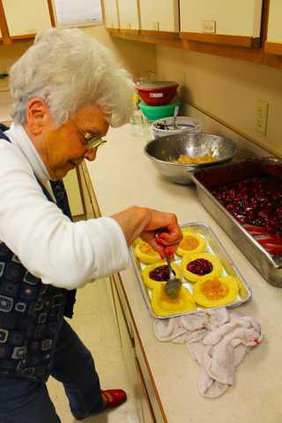Walking into the St. Rose Auditorium Friday morning, the rich, comforting scent of baking sweet bread and the chatter of friends with many hands making light work of the task of creating over a thousand kolaches fill the air. Soon, the fall kolache bake and take will bring in hundreds of eager customers hoping to get their hands on their favorites. For many, that’s poppyseed, but cherry and apricot are two other favorites.
“Eighty percent of the eggs, milk, flour and pans are donated to the altar society,” said Jerry Esfeld, president of the altar society. “We do it twice a year, fall and spring.” They make about five batches of dough an hour, and their goal was twenty batches. Each batch makes approximately 72. The last time, we had 375 pans of a half dozen each.
Fruit for filling was mostly donated also, Esfeld said. Collected when ripe, most is locally grown orchard fruit. Fillings include poppyseed, apple, cherry, plum, prune, peach and apricot. They are picked and donated to the altar society.
Why the bake? They do it for fun. “These ladies-- probably, there won’t be another time the rest of the year, other than the next kolache bake, that they gather all together. That’s probably the primary purpose.”
Secondary is money. The money they make from the bake goes into the altar society fund used to keep the altar, priest vestments, candles and funeral dinners.
The altar society bakes a German-style kolache, Esfeld said. The dough is formed into rounds, raise, press them down, put the filling in and the crumbs on top and bake. There are several variations on how the ethnic treat is prepared. Czech kolaches have the dough partially covering the filling on top, while other varieties may be rounded with the filling inside.
The dough ladies do the hard work, scooping the flour and ingredients into the bowl of the commercial sized mixer. Slowly, they add the melted butter, sugar, milk and salt to the dough, followed by the eggs, allowing the machine to do the kneading. In the past, the ladies did all the mixing and kneading by hand, and according to Donella. They used four gas ovens to bake the batches. Now, they use a commercial mixer and a convection oven, both of which speed up the process greatly.
Kathy Chacon is one of the chairpersons of the kolache bake committee. Her niece, Lorene Rawjesky, Ellinwood, came to help because she enjoys baking and spending time with the ladies of the altar society. She spent the morning carefully covering each batch of dough, monitoring its progress during its first rising, and each half dozen pan of formed dough during the second rising.
Early in the morning, the janitor arrived to heat the room to 85 degrees. How long it takes for the dough to rise varies, Esfeld said. “This morning, they found they had to add a tablespoon as yeast to each batch.”
After the second rising, Chacon and Patty Keenan help fill the kolaches, and Darlene Stross added the final touch--crumbly streusel topping. From there, the pans are brought to Donelle Brungardt, who bakes eight to twelve pans at a time. Once they have the slightly golden tone that says they’re ready, the ladies carry the pans to the cooling table. Once they are completely cooled, they slip the pans into a plastic covering to protect them and keep them fresh for when the sale begins.
“It’s turned out to be a really fun activity,” Esfeld said. “At one time, we baked on Thursday and sold them on Saturday. Well, kolaches are best when they’re freshly baked.”
Previously, the sale was paired with the all church bazaar, and the ladies baked one day, transported them to the Knights of Columbus the next, and sold them on the third.
“We had our volunteers stretched out over three days and it was a lot more of a hassle,” she said. “This works much more smoothly, and its a lot of fun too.”
This is the first year they’ve used the convection oven. It speeds up the process. Brungardt has been helping bake for 28 years, starting when her mother was president of the altar society. She takes vacation days from work in order to take part.
By the time noon arrived, the group had reached its goal of 20 batches of dough. They broke for lunch, and prepared to make cinnamon rolls in the afternoon.
They expected to run out in an hour or less. Within the first ten minutes, more than half the pans had been snatched up, with only a few trays of poppy seed left, and other single variety trays following suit.
The line to check-out was 30 feet deep with smiling customers holding two, three or more trays. Still, more customers continued to filter through the door, and the ladies continued to pull cinnamon rolls from the oven--the consolation prize for those not quick enough or wise enough to know what is worth waiting in line outside for. As one experienced shopper said, “If you want something special, you need to be here when the doors open, or you’re probably not going to get it.”
At least there is still the spring sale to look forward to.
Bakers prepare, takers watch clock





